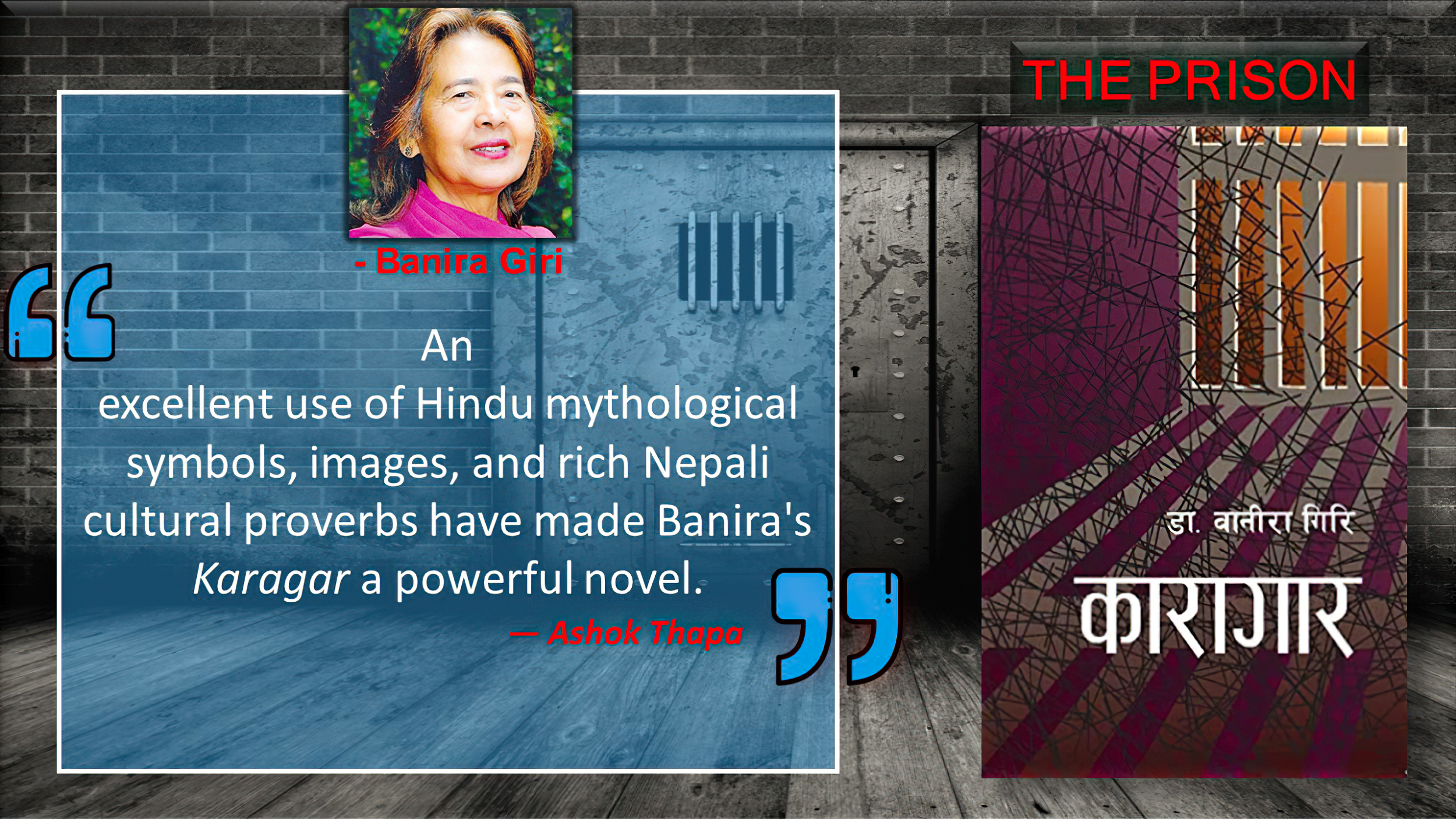
Banira Giri’s ‘Karagar’ is Still Relevant to Present Societies

DR. ASHOK THAPA
May 9, 2020
An excellent use of Hindu mythological symbols, images, and rich Nepali cultural proverbs have made Banira’s Karagar a powerful novel.
Banira Giri is the first woman to receive a Ph.D. in Nepali literature. Born in Darjeeling, India in 1946, her first and most well-known novel is Karagar, published in 1978. Ann Hunkins has translated this novel into English, and has been published as The Prison (2005). Giri’s two other novels Nirbandha and Shabdatit Shantanu were published in 1978 and 1999, consecutively. Giri, who has been suffering from Alzheimer’s for quite some time and has lost her memory power, also wrote powerful poems and essays.
Karagar is written in flashback and its characters have no names. The protagonist of this novel is an unmarried female, who was born in Jawalakhel of Kathmandu, the capital city of Nepal. At the age of 40, the female protagonist lives with her parents and two brothers. Both of her brothers are married and have a rewarding career; one is a high-ranking officer in the Army, and another is a doctor.
Everything looks good until the female character’s parents go on a pilgrimage in India and die in an accident caused by an avalanche. They had a plan of marrying their daughter after they returned.
After her parent’s death, her brothers discover a secret document in an old box in their house. Written by her father, it was a will that had said that the protagonist and her two brothers, should divide and take the parental property into equal shares. Her two brothers agree to give their sister her share of property as mentioned in the document.
But things do not go as smoothly as expected. Her brothers start delaying the marriage of their sister so she will not get a chance to take the property when she goes to her husband’s house after the marriage. In Nepali Hindu culture, especially during that time, women do not choose their husbands. They feel shy or are reluctant. It’s their eldest parents who choose and decide a husband for them. Ten years pass even after the death of her parents and she is still unmarried, and she cannot openly choose a husband and go to his home to start a new married life. Gradually, she discovers that her brothers are plotting to grab her share of property by not marrying her. She becomes frustrated by them and their wives.
Now a government officer, the protagonist, starts living in isolation in a separate rented room from her brother’s families. The protagonist older than usual to get married, but when she was younger, she liked and loved a boy secretly. She did not get a chance to express her feelings with him. Moreover, many men who came to marry her, were liars. Most of their focus was on her property and rejected them after learning about their intentions. She realizes that this society was like a prison for her. Later, she was in a relationship with another man, who was married, and he was the victim of his wife’s discrimination. One day, while returning to Kathmandu from Birgunj, a city to the south of Kathmandu, the protagonist’s boyfriend dies in an accident. She becomes incredibly sad but can’t go to see his body because her relationship with him was not formal; it was kind of a secret one and she hid her pains and feelings towards him throughout their relationship.
The novel deeply criticizes social absurdities, traditional norms and cultures, and the negative things hidden behind them. Giri attacks not only males, but also females. Feminism and sexual violence are the main themes of this novel. An issue of women’s existence is powerful here. What Karagar is trying to tell us is that “women are not free and are forced to live in social prisons like our male-dominated society” and that women have been living a vulnerable life caused by gender discrimination. Giri wants to say that such oppressions by men should not be tolerated but should be reduced by bringing them into an open debate. The novel is rich of poetic and figurative use of language as well as an excellent use of mythical symbols, images, and proverbs have made it a powerful novel.
Set around the valley of Kathmandu in particular, nature and geography have been widely portrayed in the novel. The beautiful locations Trishuli and Dakshinkali have been vividly used and indigenous places like Pashupatinath, Suryavinayak, Kamal Pokhari in Nepal and in India, famous Indian historical and cultural places like Lucknow, Vellore, Badrikedar, Patna, Kolkotta, and Delhi have been mentioned.
Many allegories from Hindu myths have made this novel. Mythological images from Hinduism such as Ramayana, Mahabharata and local imageries from Nepali folklores are vividly used here. In short, Karagar is a worth-reading novel that is still relevant to worldly readers and is timely. Anyone interested in diverse text in literary fiction based on Nepali-Hindu myth, culture, nature, and geography can find it an interesting read.


